Chinese exporters turn toward emerging markets
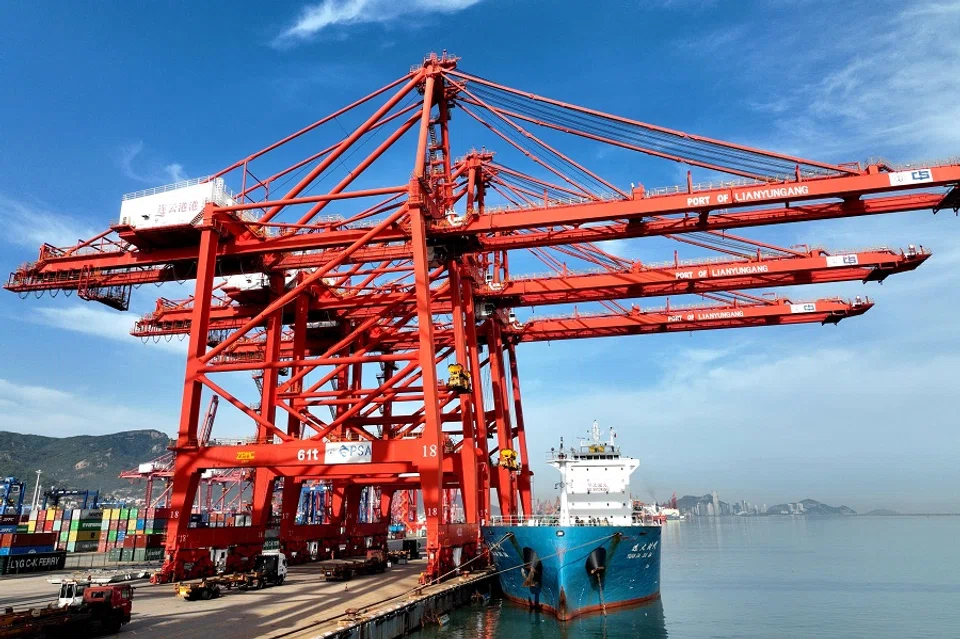
(By Caixin journalists Li Rongqian, Wang Jing and Denise Jia)
Qingdao port in eastern China opened 38 new routes in the past year, mostly to emerging countries along the route of China's Belt and Road initiative. The new routes have helped to propel Qingdao to become China's third largest container port after Shanghai and Zhoushan, handling nearly 7 million 20-foot equivalent units (TEUs) in the first quarter, an increase of 16.6% from a year earlier.
A large proportion of the containers handled in Qingdao carry intermediate materials, which are semi-finished articles used in the manufacture of final goods, and capital items including machinery and tools used to make consumer products.
In contrast, the container volume through Shanghai, which mainly handles consumer exports to North America and Europe, dropped 6.4% in the first quarter.
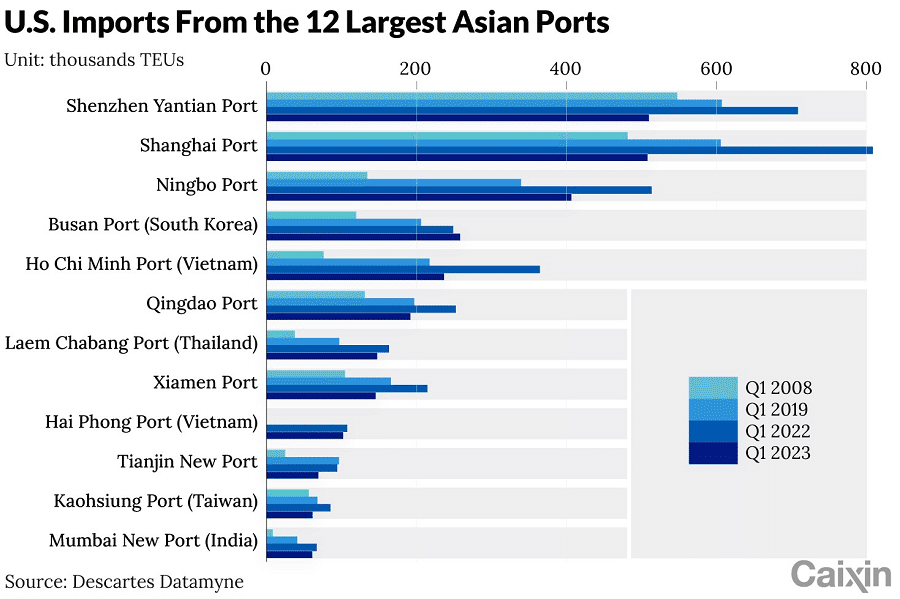
The diverging performance of China's ports reflects a shift in trade for the world's largest exporter. A growing proportion of shipments are destined for emerging markets such as countries in the Association of Southeast Asian Nations (ASEAN), the Middle East and Latin America, and an increasing share of exports consist of intermediate goods and capital items.
Strong demand from ASEAN, Latin America, Africa
The ASEAN countries accounted for 15.5% of China's total trade in 2022. In the first four months this year, China's shipments to the ten-member bloc surged 24.1% from the year-earlier period, compared with a 10.6% growth in overall exports. Shipments to Africa jumped 36.9% and exports to Latin America increased 11.2%. In the first quarter, China's exports to Saudi Arabia and the United Arab Emirates increased by 51.3% and 31.9% respectively.
Xiong Chanxin, an official at the China Council for the Promotion of International Trade, told Caixin that a group of representatives from exporters that he led on a visit to ASEAN countries last month received increased demand for consumer goods. The products sought included apparel, electronics, home appliances, and maternal and infant items. Also in high demand were new energy vehicles and auto parts.
China exports to Turkey are also surging. Since the start of the war in Ukraine, Turkey has become the transfer point for goods destined for Russia's Black Sea port, said Lin Jie, founder of Huanshi Logistics, which specialises in international trade. Shipments to Russia soared 153.1% last month from April 2022 after a 136.4% jump in March, customs data show. The growth largely resulted from increased demand for vehicles, economists at Nomura Holdings Inc. said in a report.
The shift in the balance of China's exports to more intermediate goods for emerging markets and away from finished items partly stems from the response of Western nations to supply chain disruptions caused by the three-year pandemic.

Fujian Quangong Machinery Co. Ltd., a maker of concrete block manufacturing equipment, sold 80 sets of molds to Russia last year after previously selling just two or three sets annually to the country, Du Chuncheng, the Russian regional manager, told Caixin last month at the Spring Canton Fair, the country's biggest semiannual trade exposition. In the first quarter of 2023, the company sold 40 sets of molds to Russia, he said. Now, the manufacturer plans to build a local after-sales team in Russia.
Increasing share of intermediate goods
The shift in the balance of China's exports to more intermediate goods for emerging markets and away from finished items partly stems from the response of Western nations to supply chain disruptions caused by the three-year pandemic. These countries have turned to producing more products locally or outsourcing to neighbours, trends that hurt Chinese exports of finished goods and spur shipments of intermediate components.
China's exports of intermediate goods to nations of the Belt and Road initiative rose 18.2% in the first quarter from the year-earlier period to 1.1 trillion RMB (US$158 billion), representing more than half of all exports to these countries, said Lü Daliang, director-general of the statistics and analysis department of General Administration of Customs of China.
... Indonesia wants Chinese companies to provide capital and expertise to develop local manufacturing capabilities and jobs.
Many emerging countries are now at a stage of development similar to China in the 1980s and 1990s. In their drive to develop manufacturing industries, they are no longer interested in importing finished goods. The Indonesian government recently delivered that message to a group of visiting representatives of SKE Smartkey Power Co. Ltd., a Shenzhen-based maker of power storage and solar energy products, according to Gao Qin, general manager. Instead, Indonesia wants Chinese companies to provide capital and expertise to develop local manufacturing capabilities and jobs.
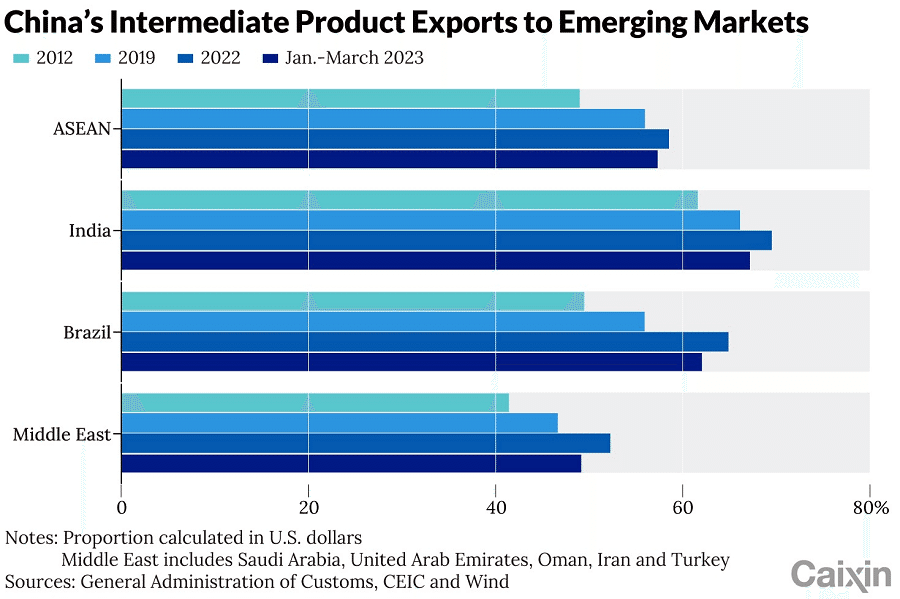
Xiong, at the China Council for the Promotion of International Trade, said he expects a large number of Chinese companies to rush into Indonesia, Malaysia or Thailand to open factories in the next three to five years. Moving production to emerging markets will drive demand for raw materials, semi-finished goods and manufacturing equipment.
Alibaba Group Holding Ltd.'s international website has seen increased demand for non-consumer goods, including machinery, from ASEAN countries, the Middle East and Mexico, Zhang Kuo, president of Alibaba's international station, told Caixin in March.
Demand for Chinese goods in the Middle East has soared in recent years, driven by infrastructure investment. For example, China's exports of excavator equipment to Saudi Arabia climbed to a record US$67.92 million in December, customs data show.
Changes in shipping routes
The shift in demand for Chinese exports is driving up prices for container shipping. On 5 May, the rates for 20-foot containers departing from Shanghai to the Persian Gulf were 50% above this year's lows, according to the Shanghai Shipping Exchange. Prices for containers to East South America were up more than 80%.
"The market is like the orchestra conductor's baton," said Wang Hailei, vice-president of shipping route management at YunQuNa, a global logistics service platform that connects cargo owners with logistics service providers. With declining rates for North American routes, shipping companies have redirected capacity to the Middle East, India and Pakistan, and South America, he said.
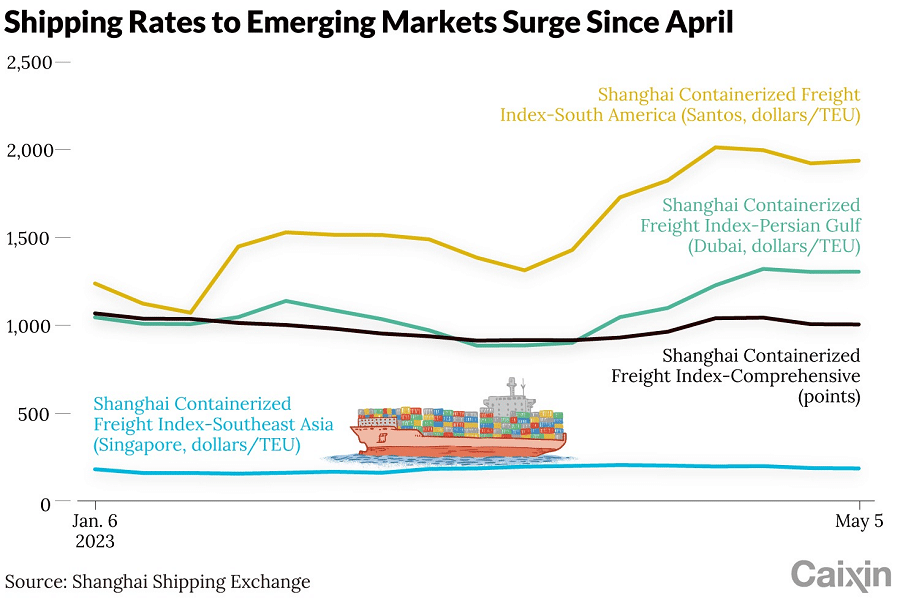
Since 2022, Maersk, Mediterranean Shipping Co., CMA CGM S.A., China COSCO, Wan Hai Lines Ltd., and Zim Integrated Shipping Ltd. have all opened new routes to South America, Wang said.
As of early April, shipping capacity between East Asia and North America was down 15% from the start of 2022, while capacity to the Middle East was up 16%, to South America up 8% and to Africa up 6%, data from shipping consultancy Alphaliner shows.
The new trends in exports are squeezing margins for China's small, private exporters.
More goods, lower prices
The new trends in exports are squeezing margins for China's small, private exporters. In the first four months this year, private companies exported 4.86 trillion RMB of goods, accounting for 63.3% of the total exports. These exporters have yet to adapt to the small-batch purchasing pattern of emerging countries.
Export orders have gradually improved after the Chinese New Year, but exporters generally complained that the size of their orders was small, and some orders were not enough to support the resumption of production at their factories, said Cai Jiaxiang, vice-president of the China Association of Foreign Trade and Economic Cooperation Enterprises.
A mug factory said a single order from European and US importers in 2020 and 2021 was usually 1.2 million mugs, compared with 100,000 to 200,000 in each order now.
A survey on 15,000 vendors at the Canton Fair showed that declining orders and shrinking order size were the main difficulties encountered by exporters, Wang Shouwen, Vice Minister of Commerce, said at a State Council press conference on 4 April.
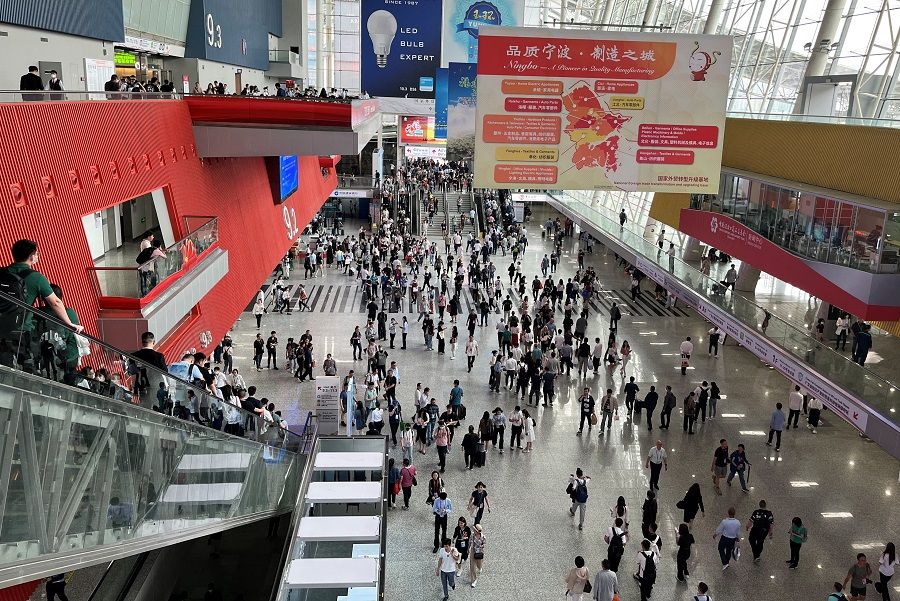
The prices that importers in developing countries can afford are also lower than those in developed countries. The mug manufacturer said its products sold to Europe and the US can get 1.5 RMB each, while now they can only fetch about 1 RMB each to emerging market buyers, notwithstanding higher production costs.
At Yiwu, a city in east China's Zhejiang province that operates the world's largest small goods market, the owner of a home remolding material store told Caixin that buyers from the Middle East and Africa usually spend a lot of time negotiating prices, leaving him only 1% to 3% profit margin on each order.
Customs data show that the export value of key goods increased 15.4% in March from a year earlier, China Post Securities said in a report. Export volume contributed 20.9 percentage points of increase, offset by 5.5 percentage points due to lower prices.
Small- to medium-sized businesses need to shift from relying on European and American markets to emerging markets. In this process, whether enterprises have clear awareness and sufficient ability to adjust quickly will determine whether they can survive in the new global trade pattern, said Wang at YunQuNa.
Modest growth estimates
In order to estimate export prospects for the rest of this year, commerce chambers covering major industries conducted a survey on orders received at the Canton Fair.
Light industry mainly involves consumer products closely related to people's daily lives such as footwear, furniture, suitcases, toys, kitchenware and jewelry. Such products accounted for more than a quarter of China's 2022 total exports of US$3.59 trillion.
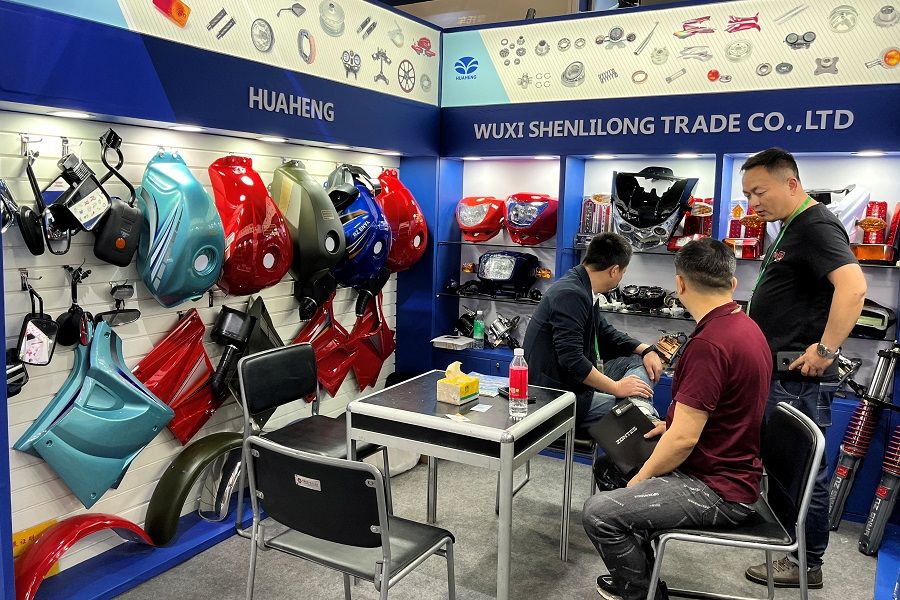
The fundamentals of China's exports will remain stable in 2023, according to China Chambers of Commerce for Import and Export of Machinery and Electronic Products, Minmetals, Light Industry, Textile, Foodstuffs, Native Produce & Animal By-Products and Medicine and Health Products.
Machinery and electronic products account for over half of China's total exports. Exports of machinery and electronic products are expected to achieve a modest growth in 2023, but the growth will probably be less than 5%, Shi Yonghong, vice-president of China Chamber of Commerce for Import and Export of Machinery and Electronic Products, told Caixin.
Light industry mainly involves consumer products closely related to people's daily lives such as footwear, furniture, suitcases, toys, kitchenware and jewelry. Such products accounted for more than a quarter of China's 2022 total exports of US$3.59 trillion. In the 2023 first quarter, exports by China's light industry fell 2.63% year-on-year to US$207.48 billion, according to the China Chamber of Commerce for Import & Export of Light Industrial Products & Arts-Crafts.
Even so, the chamber is confident of the resilience of light-industry exports and expects steady growth in 2023, Chen Jiangfeng, vice-president of the organisation, said in an interview with Caixin.
The first month export growth benefited from an exceptionally low comparison base a year earlier. Analysts expect the pace of gains to slow further in the coming months as the favourable base effect fades, and that full-year export growth will be lower than 2022's 7%.
This article was first published by Caixin Global as "Cover Story: Chinese Exporters Turn Toward Emerging Markets". Caixin Global is one of the most respected sources for macroeconomic, financial and business news and information about China.
